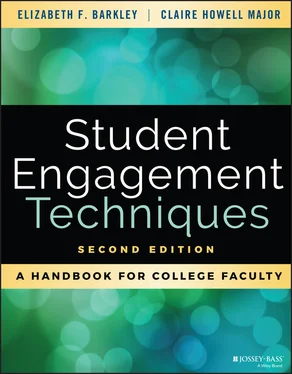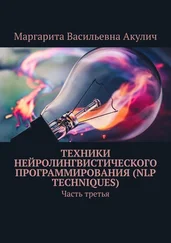Elizabeth F. Barkley - Student Engagement Techniques
Здесь есть возможность читать онлайн «Elizabeth F. Barkley - Student Engagement Techniques» — ознакомительный отрывок электронной книги совершенно бесплатно, а после прочтения отрывка купить полную версию. В некоторых случаях можно слушать аудио, скачать через торрент в формате fb2 и присутствует краткое содержание. Жанр: unrecognised, на английском языке. Описание произведения, (предисловие) а так же отзывы посетителей доступны на портале библиотеки ЛибКат.
- Название:Student Engagement Techniques
- Автор:
- Жанр:
- Год:неизвестен
- ISBN:нет данных
- Рейтинг книги:3 / 5. Голосов: 1
-
Избранное:Добавить в избранное
- Отзывы:
-
Ваша оценка:
- 60
- 1
- 2
- 3
- 4
- 5
Student Engagement Techniques: краткое содержание, описание и аннотация
Предлагаем к чтению аннотацию, описание, краткое содержание или предисловие (зависит от того, что написал сам автор книги «Student Engagement Techniques»). Если вы не нашли необходимую информацию о книге — напишите в комментариях, мы постараемся отыскать её.
— — — —
Student Engagement Techniques
"Student Engagement Techniques
"Student Engagement Techniques
"This book is an essential resource for faculty seeking to better engage with their students. Anyone seeking a clear, research-based, and actionable guide needs a copy of Student Engagement Techniques on their shelf!"
Student Engagement Techniques — читать онлайн ознакомительный отрывок
Ниже представлен текст книги, разбитый по страницам. Система сохранения места последней прочитанной страницы, позволяет с удобством читать онлайн бесплатно книгу «Student Engagement Techniques», без необходимости каждый раз заново искать на чём Вы остановились. Поставьте закладку, и сможете в любой момент перейти на страницу, на которой закончили чтение.
Интервал:
Закладка:
Condition 2: Teachers Can Create Synergy by Helping Students Work at Their Optimal Level of Challenge
One of the fundamental principles of learning is that tasks must be sufficiently difficult to pose a challenge, but not so difficult as to destroy the willingness to try (McKeachie, 1994, p. 353). Somewhere between “been there, done that” and “dazed and confused” lies the optimal level of challenge that engages students. Vygotsky (1978) coined the term zone of proximal development (ZPD) to suggest that learning is productive when learners are operating in a situation that exposes them to concepts and ideas just slightly above their current level of development. The theory, applied to student engagement, suggests that engaged learning occurs in the gap between a learner's current understanding and potential understanding. Working at the optimal challenge level creates synergy because it straddles both motivation and active learning.
In terms of motivation, Brophy (2004) suggests that anxiety and a mismatch of task to skill are the chief threats to the flow potential that characterizes deep engagement. When students face challenging tasks but do not think they possess the necessary skills, they experience anxiety; when skill is high but the task is not challenging, students become bored; when both challenge and skill level are low, students become apathetic. All three qualities—anxiousness, boredom, and apathy—characterize lack of engagement. From the perspective of active learning, an important aspect of schema theory is that the mind not only decodes what is said or written and makes the connections to existing knowledge, but also that it supplies much that is not present.
Cross (1993c) describes work done by Crawford and Chaffin (1986), who offer the simple sentence, “The little girl heard the ice cream man and rushed upstairs to get her piggy bank.” Most of us reading that sentence know what it means, even though the sentence itself says nothing about ice cream vendors moving along the street, ringing a bell, about liking or buying ice cream, or about a piggy bank containing money. The reader supplies that information from past experience, and makes the interpretation based on what he or she already knows. To someone raised on a ranch in Wyoming, all sorts of puzzling questions might arise. How did the little girl “hear” the ice cream man? Why did she rush upstairs instead of going into the ice cream store? And then just imagine the confusion of someone raised in a bustling high-rise in a non-Western country: a man made of ice cream? What is this odd American association between pigs and banks?
Meaningful learning requires some combination of both the incoming message and prior knowledge. For new learning to take place, it has to be related to what the learner already knows. If students have nothing to connect new information to—no associational hooks on which to hang the data—they may feel bewildered and overwhelmed. Therefore, it is essential for a teacher to understand how students are incorporating new information into what they already know in order to help students work in their optimal challenge zone and achieve the deep, meaningful learning essential to engagement.
The challenge for teachers is that classes generally enroll a minimum of 15–20 students, and these students are often quite diverse. Recognizing that individual learners within a single class are most likely at different points in terms of their learning gaps and hence have distinct zones of optimal challenge, how could a teacher possibly individualize the curriculum to meet each student's unique needs? Is it inevitable that some students will be bored and others confused and frustrated? Not necessarily. Assessment, teaching students metacognitive skills, and empowering students as partners in their own learning are three broad approaches to helping students work in their optimal challenge zones.
Assessment and Feedback
Most college teachers recognize that collecting feedback on students' learning can help them adjust their teaching approaches to make learning more efficient and effective. Similarly, if our goal is to promote engaged learning, we are likely to be more successful if we gather feedback on how well our efforts to set up the classroom conditions that we believe create engagement actually do foster engagement, and then adjust our teaching accordingly. The core purpose of assessment from this perspective is to educate and improve student engagement, not to audit it.
Learners need to know how well they are doing and how they can do better. Effective teaching is not simply providing information—a textbook, video, or podcast can do that as well and often better. Rather, a teacher's value comes in the careful observation, analysis, and feedback to a learner that enables improvement.
Summative, Formative, and Educative Assessment
Summative assessment is the summary evaluation at the end of a topic, unit, or program for “auditing” purposes, usually to produce a grade. It is essentially “product”-focused. Tests are the traditional vehicle for this type of assessment. Formative assessment is more process-oriented and developmental in nature. Its primary purpose is to provide feedback that encourages adjustments and corrections. Classroom assessment techniques, for example, provide individual college teachers with a variety of ways to determine how well their students are engaged in learning. Whatever means teachers use to assess engagement in their classes, gathering appropriate feedback can help to close the gap between what teachers think is happening in their classes and what students are actually experiencing. Both summative and formative types of assessment are valuable and necessary and, in practice, often blended.
A term used by Grant Wiggins (1998) that seems to incorporate both summative and formative aspects is educative assessment . Educative assessment is deliberately designed to promote as well as measure learning. Critical elements include identifying and communicating learning goals to students, specifying the criteria or evidence that will be used to determine whether the students have met the goals, and providing students with rich, timely, individually relevant feedback that provides opportunities for intervention and adjustment before it is too late (pp. 12–13). We have a similar definition of assessment in our book titled Learning Assessment Techniques: A Handbook for College Teachers (Barkley & Major, 2016); we view learning assessment as a seamless approach to teaching, learning, and assessment. As we see it, when done well, students should not be able to distinguish whether they are being taught or assessed.
Authentic Assessment
An additional element stressed by Wiggins and others is authentic assessment, an approach to assessment that developed out of the concern that conventional assessment instruments tend to focus on the more superficial and easily tested aspects of knowledge and do not replicate the kinds of challenges that adults face in the workplace, civic affairs, or in their personal lives. Authentic assessment aims to be realistic, which means the task(s) reproduce the ways and the contexts in which a person's knowledge and abilities are “tested” in real-world situations. This typically involves the student “doing” the subject. Instead of reciting, restating, or replicating through demonstration what he or she was taught or what is already known, the student has to carry out the kind of exploration and work that constitutes “doing” the discipline.
Second, authentic assessment requires judgment, innovation, and efficient and effective use of a repertoire of knowledge and skills to negotiate a complex task or solve complex problems. In other words, rather than consisting of isolated elements of performance, authentic assessment requires students to integrate multiple elements. Third, authentic assessment focuses on being formative, allowing appropriate opportunities to rehearse, practice, consult resources, and get feedback on and refine performances and products (Wiggins, 1998, pp. 23–24). What constitutes an “authentic assessment task” is discipline and course-specific, but for example in a history course, rather than testing whether a student can remember the facts of history, an authentic assessment task might ask students to research a controversial historical account to determine the facts. Because authentic assessment tasks seem more relevant and also tend to be more interesting, students are often more motivated to do them than they are to do conventional assessment activities. Additionally, because of their greater complexity, they can allow for a range of responses that can encourage students to work within their optimal challenge zone.
Читать дальшеИнтервал:
Закладка:
Похожие книги на «Student Engagement Techniques»
Представляем Вашему вниманию похожие книги на «Student Engagement Techniques» списком для выбора. Мы отобрали схожую по названию и смыслу литературу в надежде предоставить читателям больше вариантов отыскать новые, интересные, ещё непрочитанные произведения.
Обсуждение, отзывы о книге «Student Engagement Techniques» и просто собственные мнения читателей. Оставьте ваши комментарии, напишите, что Вы думаете о произведении, его смысле или главных героях. Укажите что конкретно понравилось, а что нет, и почему Вы так считаете.












